Effects of Correlated Colour Temperature of LED Light on Visual Sensation, Perception, and Cognitive Performance in a Classroom Lighting Environment
Abstract
1. Introduction
2. Method
2.1. Participants
2.2. Experimental Conditions
2.3. Working Memory Testing
2.4. Subjective Measurement
2.5. Experimental Design and Procedure
3. Results
3.1. Sensation: Bright, Dark, Warm, Cool, and Glare
3.2. Perception: Lighting Comfort, Satisfaction, and Acceptance
3.3. Working Memory Testing: Digit Span Backward and Letter-Number Sequencing
4. Discussion
4.1. The Levels of Brain Processing in the Subjective Attributes and the CCT Effects
4.2. The CCT Effects on Cognitive Performance
4.3. Gender Differences in the Lighting Environment
4.4. Optimal CCT in Educational Settings
4.5. Limitations
5. Conclusions
Author Contributions
Funding
Conflicts of Interest
Appendix A
| No | Type | Set 1 | Set 2 | Set 3 | Set 4 | Set 5 | Set 6 | Set 7 |
|---|---|---|---|---|---|---|---|---|
| 1 | DSB | 582 | 694 | 629 | 475 | 316 | 904 | 827 |
| Ans. | 285 | 496 | 926 | 574 | 613 | 409 | 728 | |
| 2 | DSB | 7286 | 6439 | 8279 | 4968 | 8792 | 4871 | 9437 |
| Ans. | 6827 | 9346 | 9728 | 8694 | 2978 | 1784 | 7349 | |
| 3 | DSB | 42731 | 75836 | 65843 | 15486 | 46917 | 38358 | 62183 |
| Ans. | 13724 | 63857 | 34856 | 68451 | 71964 | 85383 | 38126 | |
| 4 | DSB | 392487 | 619473 | 537418 | 724856 | 517936 | 625284 | 728156 |
| Ans. | 784293 | 374916 | 814735 | 658427 | 639715 | 482526 | 651827 | |
| 5 | DSB | 4179386 | 6917428 | 8149362 | 4739628 | 7576862 | 4825435 | 3465182 |
| Ans. | 6839714 | 8247196 | 2639418 | 8269374 | 2686757 | 5345284 | 2815643 | |
| 6 | LNS | 2 Fri 7 | Tue 96 | 3 Thu 7 | Sat 9 Fri | Wed 6 Thu | Fri 2 Tue | 93 Sat |
| Ans. | 27fri | 69tue | 37thu | 9frisat | 6wedthu | 2tuefri | 39sat | |
| 7 | LNS | Sat 3 Wed 5 | 7 Fri 4 Thu | Fri 9 Sat 6 | Mon 4 Thu 6 | 8 Sat 5 Fri | Sat 1 Mon 7 | 7 Thu 5 Tue |
| Ans. | 35wedsat | 47thufri | 69frisat | 46monthu | 58frisat | 17monsat | 57tuethu | |
| 8 | LNS | 8 Tue 6 Wed 3 | Wed 4 Mon 2 Sat | 5 Fri 3 Tue 6 | 9 Wed 7 Thu 4 | Thu 6 Tue 3 Mon | 6 Sat 4 Wed 7 | 3 Mon 6 Fri Wed |
| Ans. | 368tuewed | 24monwedsat | 356tuefri | 479wedthu | 36montuethu | 467wedsat | 36monwedfri | |
| 9 | LNS | Tue 4 Fri 7 Sat 2 | 6 Mon 9 Wed 2 Thu | Fri 6 Wed 5 Tue 3 | Wed 5 Sat 8 Mon 3 | 7 Tue 1 Thu 3 Fri | Sat 7 Thu 6 Wed 4 | Sat 2 Mon 4 Thu 3 |
| Ans. | 247tuefrisat | 269monwedthu | 356tuewedfri | 358monwedsat | 137tuethufri | 467wedthusat | 234monthusat | |
| 10 | LNS | Mon 7 Fri 4 Sat 8 Tue | 9 Thu 2 Mon 3 Wed 7 | Tue 2 Thu 8 Fir 4 Mon | Tue 8 Sat 5 Mon 9 Wed | 1 Fri 3 Tue 4 Thu 8 | Wed 3 Fri 9 Sat 5 Tue | Fri 5 Tue 6 Thu 9 Mon |
| Ans. | 478montuefrisat | 2379monwedthu | 248montuethufri | 589montuewedsat | 1348tuethufri | 359tuewedfrisat | 569montuethufri |
References
- Barkmann, C.; Wessolowski, N.; Schulte-Markwort, M. Applicability and efficacy of variable light in schools. Physiol. Behav. 2012, 105, 621–627. [Google Scholar] [CrossRef]
- Shamsul, B.; Sia, C.; Ng, Y.; Karmegan, K. Effects of light’s colour temperatures on visual comfort level, task performances, and alertness among students. Am. J. Public Health Res. 2013, 1, 159–165. [Google Scholar] [CrossRef]
- CIBSE. SSL Code for Lighting; The Society of Light and Lighting: Oxford, UK, 2012. [Google Scholar]
- IES. IESNA Lighting Handbook: Reference & Application; Illuminating Engineering Society of North America: New York, NY, USA, 2011. [Google Scholar]
- Korean Standards Association. KS A 3011: 1998 Recommended levels of illumination; KATS: Eumseong, Korea, 1998. [Google Scholar]
- Kruithof, A.A. Tubular Luminescence Lamps for General Illumination. Philips Tech. Rev. 1941, 6, 65–96. [Google Scholar]
- Boyce, P.R.; Cuttle, C. Effect of correlated colour temperature on the perception of interiors and colour discrimination performance. Light. Res. Technol. 1990, 22, 19–36. [Google Scholar] [CrossRef]
- Kakitsuba, N. Comfortable indoor lighting conditions evaluated from psychological and physiological responses. Leukos 2016, 12, 163–172. [Google Scholar] [CrossRef]
- Harrington, R. Effect of color temperature on apparent brightness. J. Opt. Soc. Am. 1954, 44, 113–116. [Google Scholar] [CrossRef]
- Fotios, S.; Levermore, G. Perception of electric light sources of different colour properties. Light. Res. Technol. 1997, 29, 161–171. [Google Scholar] [CrossRef]
- Ju, J.; Chen, D.; Lin, Y. Effects of correlated color temperature on spatial brightness perception. Color Res. Appl. 2012, 37, 450–454. [Google Scholar] [CrossRef]
- Kim, I.-T.; Jang, I.-H.; Choi, A.-S.; Sung, M. Brightness perception of white LED lights with different correlated colour temperatures. Indoor Built Environ. 2015, 24, 500–513. [Google Scholar] [CrossRef]
- Akashi, Y.; Boyce, P. A field study of illuminance reduction. Energy Build. 2006, 38, 588–599. [Google Scholar] [CrossRef]
- Wei, M.; Houser, K.W.; Orland, B.; Lang, D.H.; Ram, N.; Sliwinski, M.J.; Bose, M. Field study of office worker responses to fluorescent lighting of different CCT and lumen output. J. Environ. Psychol. 2014, 39, 62–76. [Google Scholar] [CrossRef]
- Baniya, R.R.; Tetri, E.; Halonen, L. A study of preferred illuminance and correlated colour temperature for LED office lighting. Light Eng. 2015, 23, 39–47. [Google Scholar]
- Yu, H.; Akita, T. The effect of illuminance and correlated colour temperature on perceived comfort according to reading behaviour in a capsule hotel. Build. Environ. 2019, 148, 384–393. [Google Scholar] [CrossRef]
- Lee, J.-H.; Moon, J.W.; Kim, S. Analysis of occupants’ visual perception to refine indoor lighting environment for office tasks. Energies 2014, 7, 4116–4139. [Google Scholar] [CrossRef]
- Islam, M.; Dangol, R.; Hyvärinen, M.; Bhusal, P.; Puolakka, M.; Halonen, L. User acceptance studies for LED office lighting: Lamp spectrum, spatial brightness and illuminance. Light. Res. Technol. 2015, 47, 54–79. [Google Scholar] [CrossRef]
- Wang, Q.; Xu, H.; Zhang, F.; Wang, Z. Influence of color temperature on comfort and preference for LED indoor lighting. Optik 2017, 129, 21–29. [Google Scholar] [CrossRef]
- Nakamura, H.; Karasawa, Y. Relationship between illuminance/color temperature and preference of atmosphere. J. Light Vis. Environ. 1999, 23, 29–38. [Google Scholar] [CrossRef]
- Park, B.-C.; Chang, J.-H.; Kim, Y.-S.; Jeong, J.-W.; Choi, A.-S. A study on the subjective response for corrected colour temperature conditions in a specific space. Indoor Built Environ. 2010, 19, 623–637. [Google Scholar] [CrossRef]
- Kocaoğlu, R. The Effects of Correlated Color Temperature on Sustained Attention and Mood of University Students in Learning Environments; Bilkent University: Çankaya, Ankara, Turkey, 2015. [Google Scholar]
- Davis, R.G.; Ginthner, D.N. Correlated color temperature, illuminance level, and the Kruithof curve. J. Illum. Eng. Soc. 1990, 19, 27–38. [Google Scholar] [CrossRef]
- Hu, X.; Houser, K.W.; Tiller, D.K. Higher color temperature lamps may not appear brighter. Leukos 2006, 3, 69–81. [Google Scholar] [CrossRef]
- Ru, T.; de Kort, Y.A.; Smolders, K.C.; Chen, Q.; Zhou, G. Non-image forming effects of illuminance and correlated color temperature of office light on alertness, mood, and performance across cognitive domains. Build. Environ. 2019, 149, 253–263. [Google Scholar] [CrossRef]
- Fotios, S. A revised Kruithof graph based on empirical data. Leukos 2017, 13, 3–17. [Google Scholar] [CrossRef]
- Deguchi, T.; Sato, M. The effect of color temperature of lighting sources on mental activity level. Ann. Physiol. Anthr. 1992, 11, 37–43. [Google Scholar] [CrossRef]
- Mukae, H.; Sato, M. The effect of color temperature of lighting sources on the autonomic nervous functions. Ann. Physiol. Anthr. 1992, 11, 533–538. [Google Scholar] [CrossRef]
- Noguchi, H.; Sakaguchi, T. Effect of illuminance and color temperature on lowering of physiological activity. Appl. Hum. Sci. J. Physiol. Anthr. 1999, 18, 117–123. [Google Scholar] [CrossRef]
- Navvab, M. A comparison of visual performance under high and low color temperature fluorescent lamps. J. Illum. Eng. Soc. 2001, 30, 170–175. [Google Scholar] [CrossRef]
- Boyce, P.; Akashi, Y.; Hunter, C.; Bullough, J. The impact of spectral power distribution on the performance of an achromatic visual task. Light. Res. Technol. 2003, 35, 141–156. [Google Scholar] [CrossRef]
- Yamagishi, M.; Yamaba, K.; Kubo, C.; Nokura, K.; Nagata, M. Effects of LED lighting characteristics on visual performance of elderly people. Gerontechnology 2008, 7, 243. [Google Scholar] [CrossRef]
- Huang, R.H.; Lee, L.; Chiu, Y.A.; Sun, Y. Effects of correlated color temperature on focused and sustained attention under white LED desk lighting. Color Res. Appl. 2015, 40, 281–286. [Google Scholar] [CrossRef]
- Luo, M.R.; Wang, M.; Liu, Y. The impact of LED lighting on people’s work performance between different age groups. In Proceedings of the 2018 15th China International Forum on Solid State Lighting: International Forum on Wide Bandgap Semiconductors China (SSLChina: IFWS), Shenzhen, Guangdong, China, 23–25 October 2018. [Google Scholar]
- Pulay, A.; Read, M.; Tural, E.; Lee, S. Examining Student Behavior under Two Correlated Color Temperature Levels of Lighting in an Elementary School Classroom. Educ. Plan. 2018, 23, 58–69. [Google Scholar]
- Boray, P.F.; Gifford, R.; Rosenblood, L. Effects of warm white, cool white and full-spectrum fluorescent lighting on simple cognitive performance, mood and ratings of others. J. Environ. Psychol. 1989, 9, 297–307. [Google Scholar] [CrossRef]
- Davis, R.G.; Garza, A. Task lighting for the elderly. J. Illum. Eng. Soc. 2002, 31, 20–32. [Google Scholar] [CrossRef]
- Wechsler, D. Korean Wechsler Adult Intelligence Scale–IV; K-WAIS-IV; Psychology Co., Ltd.: Deagu, Korea, Korea, 2008; Volume 22. [Google Scholar]
- Wechsler, D. Wechsler Adult Intelligence Scale–Fourth Edition (WAIS–IV); Pearson Assessments: San Antonio, TX, USA, 2008. [Google Scholar]
- Reips, U.-D.; Funke, F. Interval-level measurement with visual analogue scales in Internet-based research: VAS Generator. J. Behav. Res. Methods 2008, 40, 699–704. [Google Scholar] [CrossRef] [PubMed]
- Yang, W.; Moon, H.J.; Jeon, J.Y. Comparison of response scales as measures of indoor environmental perception in combined thermal and acoustic conditions. Sustainability 2019, 11, 3975. [Google Scholar] [CrossRef]
- Pirenne, M.H. Dark Adaptation and Night Vision. In The Eye; Chapter 5; Davson, H., Ed.; Academic Press: London, UK, 1962; Volume 2. [Google Scholar]
- Budescu, D.V.; Appelbaum, M.I. Variance Stabilizing Transformations and the Power of the F Test. J. Educ. Stat. 1981, 6, 55–74. [Google Scholar] [CrossRef]
- Goldstein, E.B.; Brockmole, J. Sensation and Perception; Cengage Learning: Boston, MA, USA, 2016. [Google Scholar]
- Manav, B. An experimental study on the appraisal of the visual environment at offices in relation to colour temperature and illuminance. Build. Environ. 2007, 42, 979–983. [Google Scholar] [CrossRef]
- Kakitsuba, N. Comfortable indoor lighting conditions for LEDlights evaluated from psychological and physiological responses. Appl. Ergon. 2020, 82, 102941. [Google Scholar] [CrossRef]
- Rodriguez, R.; Yamín Garretón, J.; Pattini, A. Glare and cognitive performance in screen work in the presence of sunlight. Light. Res. Technol. 2016, 48, 221–238. [Google Scholar] [CrossRef]

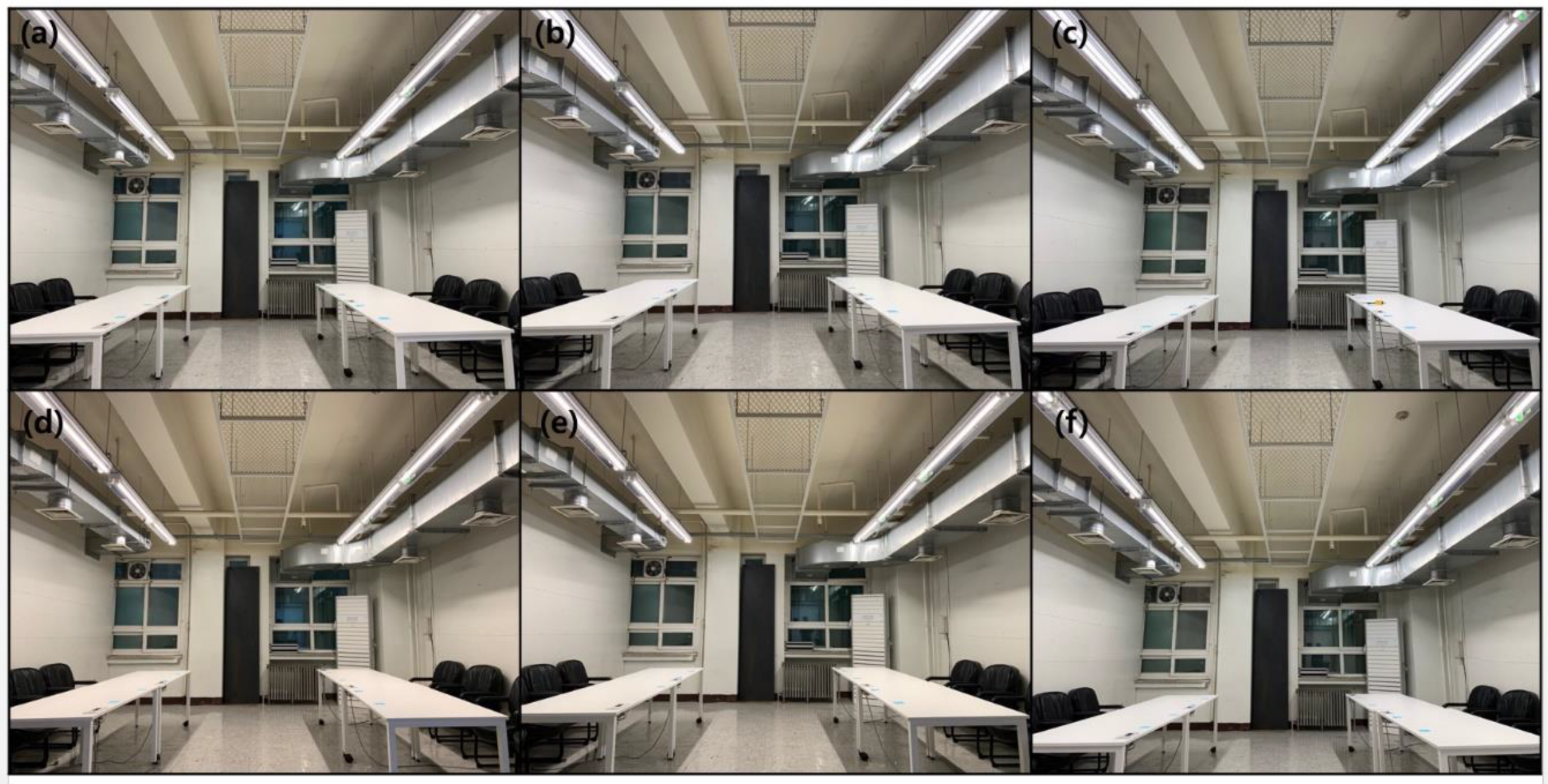


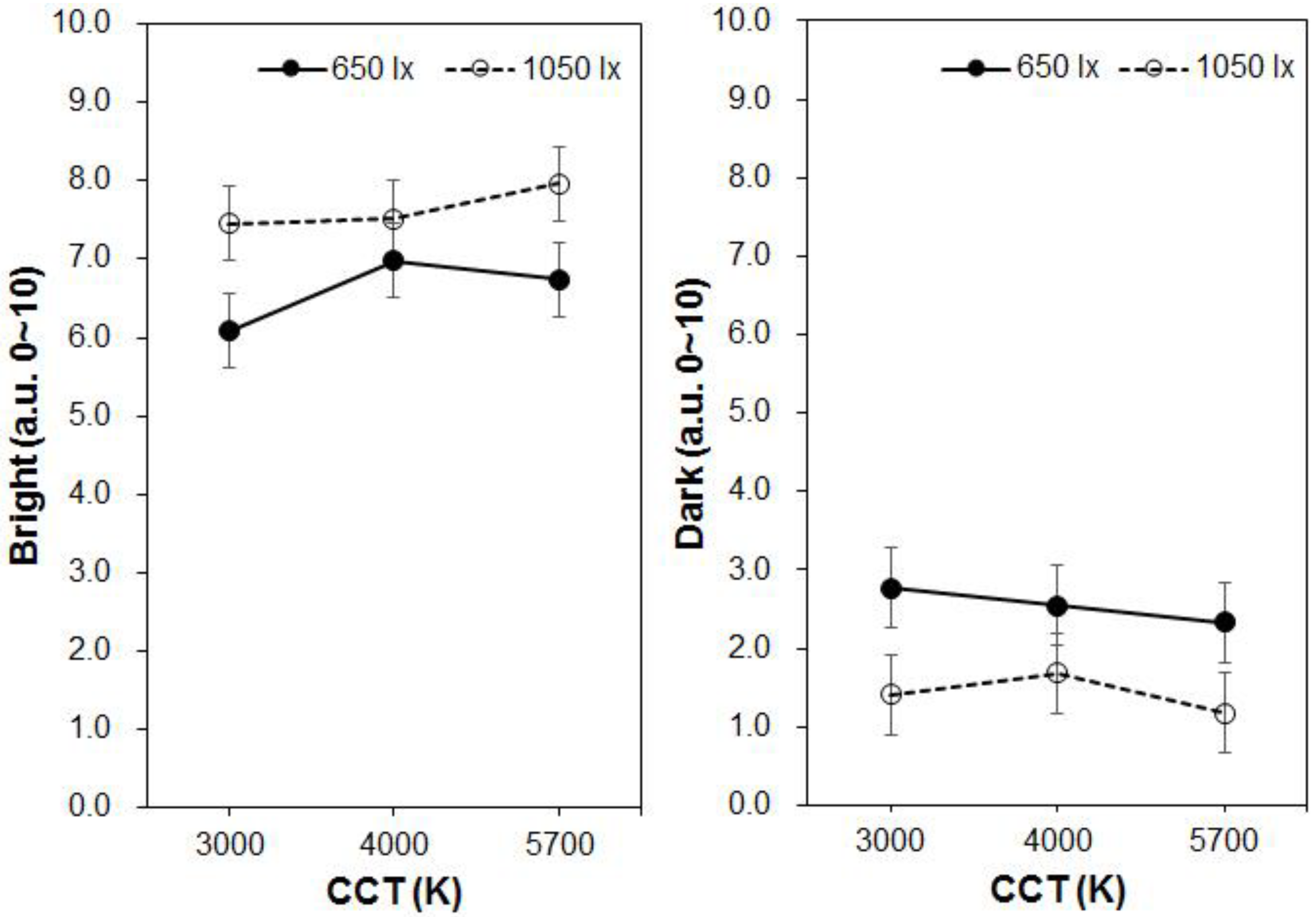
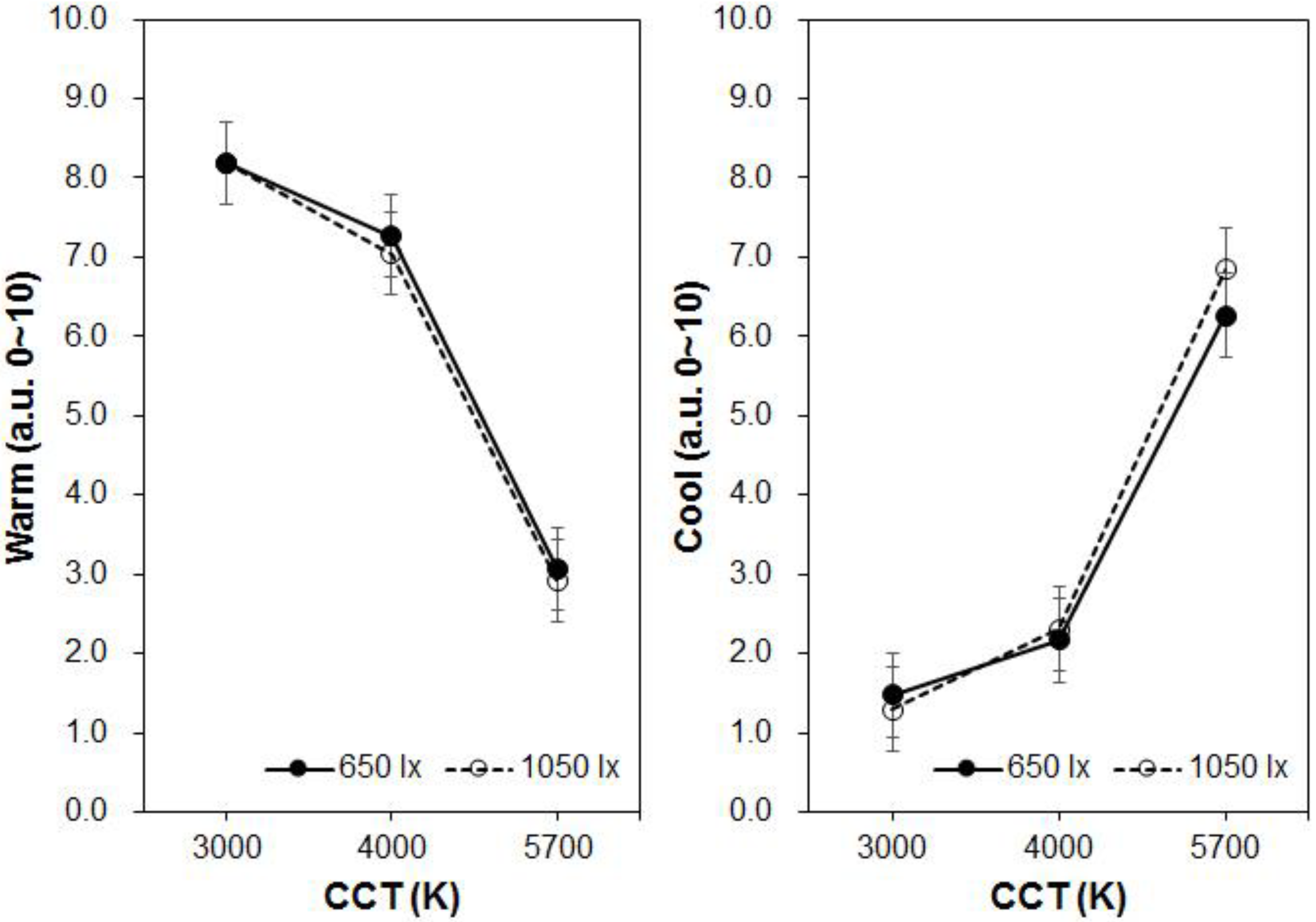
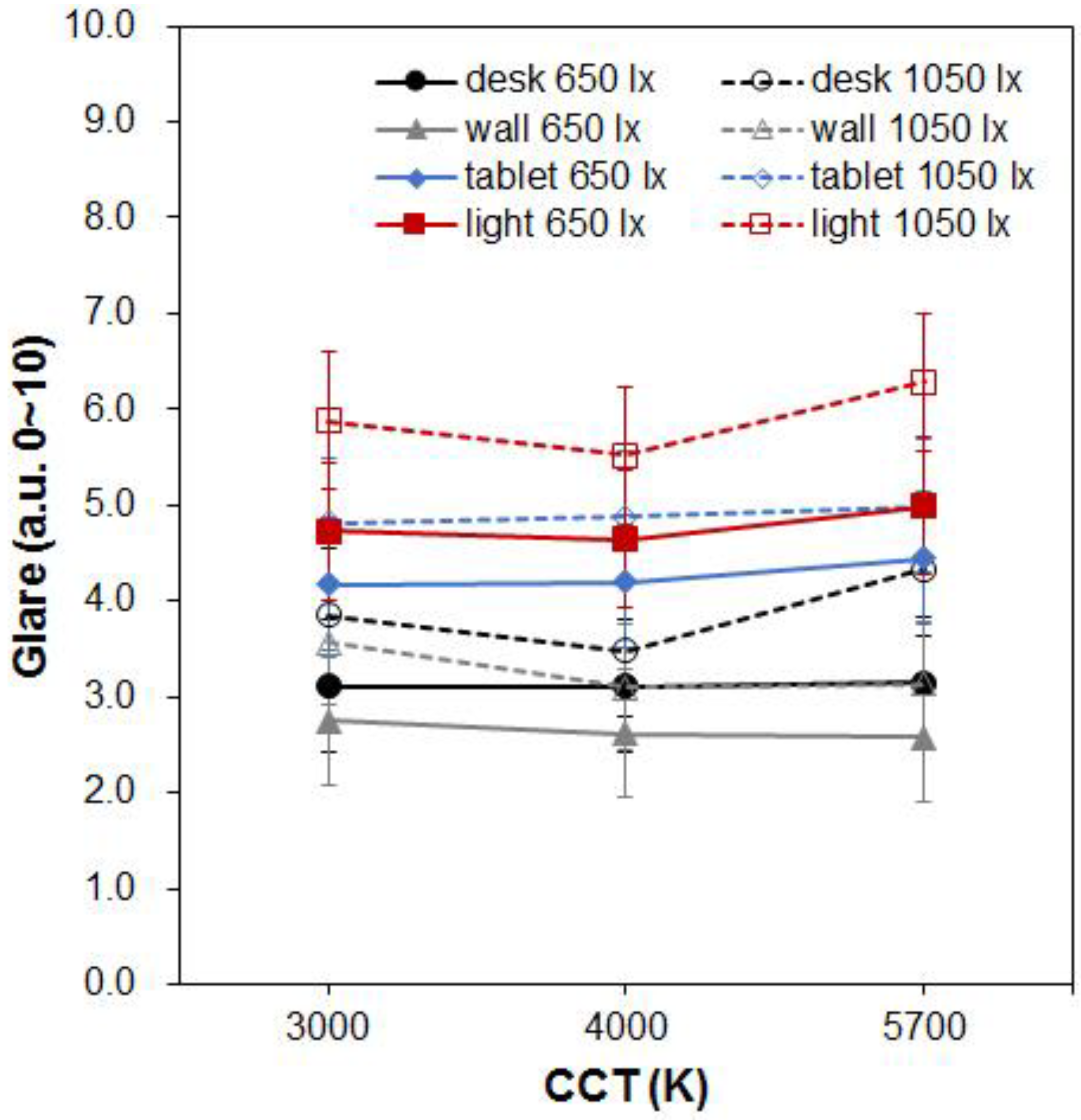
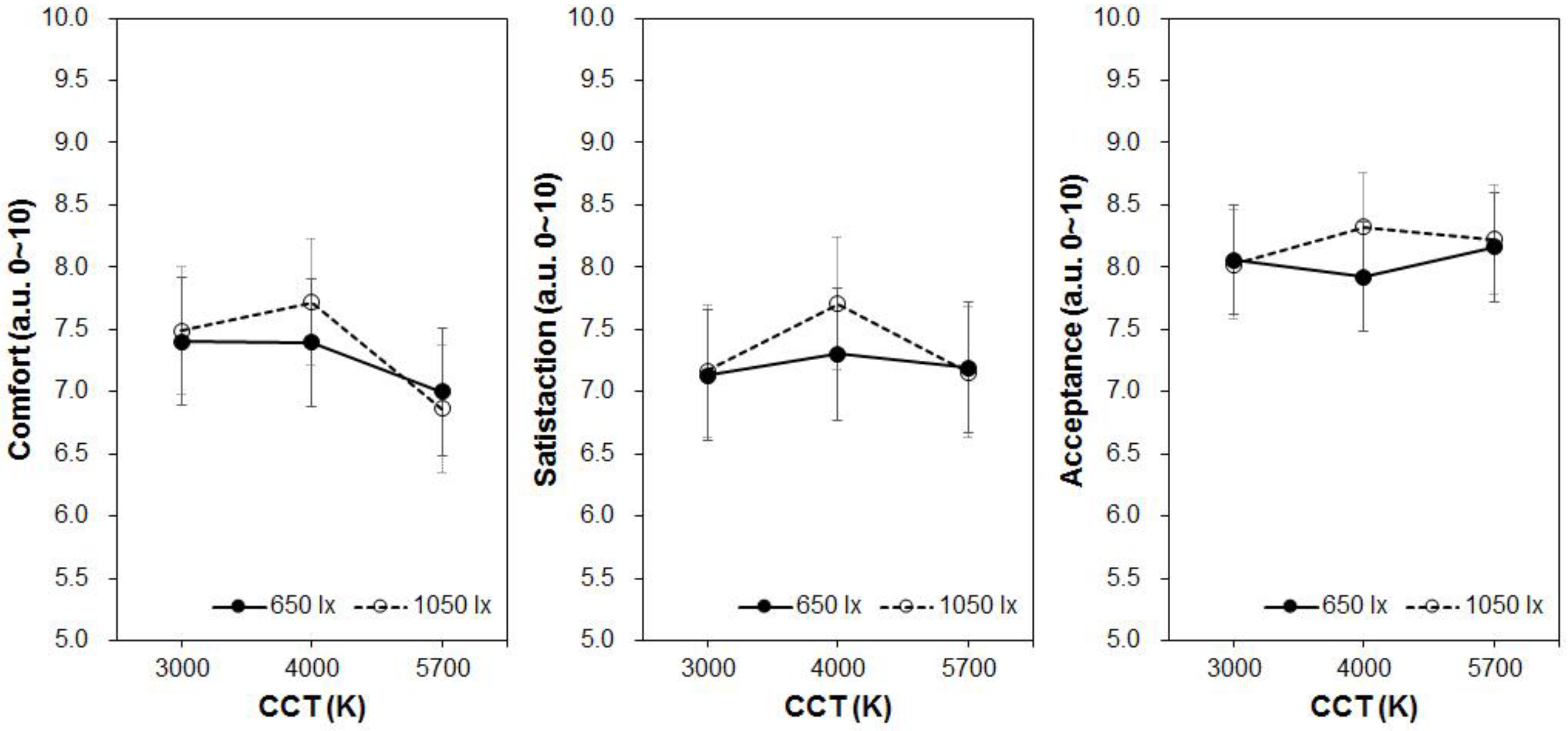

| 3000 K | 3000 K | 4000 K | 4000 K | 5700 K | 5700 K | |
|---|---|---|---|---|---|---|
| 650 lx | 1050 lx | 650 lx | 1050 lx | 650 lx | 1050 lx | |
| Illuminance (lx) | 653 | 1060 | 637 | 1044 | 641 | 1080 |
| CCT (K) | 3066 | 3080 | 4046 | 4067 | 5789 | 5778 |
| CCT | N | Bright | Dark | Warm | Cool | |||||
| 3000 K | Mean | 120 | 6.77 | B | 2.088 | A | 8.124 | A | 1.389 | C |
| 4000 K | Mean | 120 | 7.25 | AB | 2.111 | A | 7.154 | B | 2.245 | B |
| 5700 K | Mean | 120 | 7.35 | A | 1.753 | A | 3.003 | C | 6.553 | A |
| F | 3.17 | 1.10 | 207.84 | 206.61 | ||||||
| P | 0.043 | 0.334 | 0.000 | 0.000 | ||||||
| Illuminance | N | Bright | Dark | Warm | Cool | |||||
| 650 lx | Mean | 180 | 6.601 | B | 2.546 | A | 6.133 | A | 3.309 | A |
| 1050 lx | Mean | 180 | 7.643 | A | 1.422 | B | 6.053 | A | 3.482 | A |
| F | 26.68 | 27.86 | 0.14 | 0.6 | ||||||
| P | 0.000 | 0.000 | 0.712 | 0.439 | ||||||
| Gender | N | Desk | Wall | Tablet | Light | |||||
|---|---|---|---|---|---|---|---|---|---|---|
| Women | Mean | 180 | 4.14674 | A | 3.59669 | A | 5.12652 | A | 5.81955 | A |
| Men | Mean | 180 | 2.88198 | B | 2.33956 | B | 4.05747 | B | 4.87637 | B |
| F | 4.56 | 5.42 | 4.94 | 14.05 | ||||||
| P | 0.006 | 0.02 | 0.027 | 0.000 | ||||||
| CCT, Overall | N | Comfort | Satisfaction | Acceptance | ||||
| 3000 | Mean | 120 | 7.45 | AB | 7.15 | A | 8.04 | A |
| 4000 | Mean | 120 | 7.56 | A | 7.50 | A | 8.12 | A |
| 5700 | Mean | 120 | 6.93 | B | 7.18 | A | 8.19 | A |
| F | 3.34 | 1.07 | 0.23 | |||||
| P | 0.036 | 0.343 | 0.797 | |||||
| CCT, 650 lx | N | Comfort | Satisfaction | Acceptance | ||||
| 3000 | Mean | 60 | 7.404 | A | 7.133 | A | 8.061 | A |
| 4000 | Mean | 60 | 7.396 | A | 7.306 | A | 7.920 | A |
| 5700 | Mean | 60 | 6.999 | A | 7.195 | A | 8.163 | A |
| F | 0.79 | 0.40 | 0.29 | |||||
| P | 0.457 | 0.901 | 0.752 | |||||
| CCT, 1050 lx | N | Comfort | Satisfaction | Acceptance | ||||
| 3000 | Mean | 60 | 7.491 | A | 7.168 | A | 8.023 | A |
| 4000 | Mean | 60 | 7.720 | A | 7.705 | A | 8.321 | A |
| 5700 | Mean | 60 | 6.864 | A | 7.158 | A | 8.223 | A |
| F | 2.95 | 1.35 | 0.48 | |||||
| P | 0.055 | 0.262 | 0.622 | |||||
| Gender | N | Score | Score By CCT | Score by Illuminance | ||||||||
|---|---|---|---|---|---|---|---|---|---|---|---|---|
| 3000 K | 4000 K | 5700 K | 650 lx | 1050 lx | ||||||||
| N = 60 | N = 60 | N = 60 | F | P | N = 90 | N = 90 | F | P | ||||
| Men | Mean | 180 | 9.528 | 9.288 | 9.667 | 9.633 | 3.29 | 0.040 | 9.689 | 9.371 | 5.72 | 0.018 |
| Women | Mean | 180 | 9.291 | 9.450 | 9.633 | 9.300 | 2.52 | 0.083 | 9.233 | 9.348 | 0.64 | 0.426 |
| F | 5.98 | |||||||||||
| P | 0.015 | |||||||||||
© 2020 by the authors. Licensee MDPI, Basel, Switzerland. This article is an open access article distributed under the terms and conditions of the Creative Commons Attribution (CC BY) license (http://creativecommons.org/licenses/by/4.0/).
Share and Cite
Yang, W.; Jeon, J.Y. Effects of Correlated Colour Temperature of LED Light on Visual Sensation, Perception, and Cognitive Performance in a Classroom Lighting Environment. Sustainability 2020, 12, 4051. https://doi.org/10.3390/su12104051
Yang W, Jeon JY. Effects of Correlated Colour Temperature of LED Light on Visual Sensation, Perception, and Cognitive Performance in a Classroom Lighting Environment. Sustainability. 2020; 12(10):4051. https://doi.org/10.3390/su12104051
Chicago/Turabian StyleYang, Wonyoung, and Jin Yong Jeon. 2020. "Effects of Correlated Colour Temperature of LED Light on Visual Sensation, Perception, and Cognitive Performance in a Classroom Lighting Environment" Sustainability 12, no. 10: 4051. https://doi.org/10.3390/su12104051
APA StyleYang, W., & Jeon, J. Y. (2020). Effects of Correlated Colour Temperature of LED Light on Visual Sensation, Perception, and Cognitive Performance in a Classroom Lighting Environment. Sustainability, 12(10), 4051. https://doi.org/10.3390/su12104051





